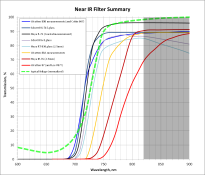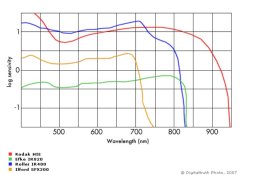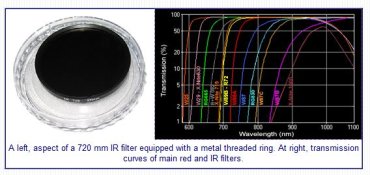Georgios, I have been undertaking a similar exploration with the Rollei infrared-capable films - specifically, to see if I could capture more of the Efke IR820c "look" by pushing the filter pass farther into the IR. Although I haven't tried a 780nm filter, my preliminary testing indicates that a 750nm filter (Wratten 88A) requires about 2 stops more exposure than a 720nm filter (Hoya R72). Given how precipitous the spectral response of the 400 film is, I can believe DWThomas's result of 6 more stops for a 760nm filter, and I would suspect that at 780nm exposure times are getting to the point of being just about un-doable (since reciprocity failure must be kicking in eventually and is probably pretty severe).
But I can report that I am seeing a noticeably stronger Wood effect, darker sky, darker red objects, etc. with the 750nm filter over the 720nm filter (although frankly it is still not quite the same as what the Efke film provided). My suspicion is that there is not much to be gained by cutting off past the 750-760nm region though. My thinking for that has to do with the fact that these films have relatively high sensitivity right up through the high 600's and low 700's (in nanometers), but then fall off so sharply after that - right at the point at which foliage really begins to "turn on". I compiled a chart of data for different IR filters (see below) to see how their spectral responses compared to a typical foliage response. I think this shows why the "look" of these films is a little different than the older emulsions - basically you're getting a higher percentage of the tail end of the visible spectrum relative to "the good stuff" just into the infrared, since the sensitivity is falling off so quickly at that point. My reasoning for the Wratten 88A filter was that if you could cut out just a little more of the light in that transition region you would be left with a "purer" infrared exposure (albeit at the expense of considerably longer exposure times).
One of the frustrations with all of this is that reliable data is hard to come by, and there is a great deal of uncertain information online. As an example, it appears to me that the curve for Rollei IR400 film shown on the
infrared film spectral sensitivity comparison chart on the digitaltruth website is shifted by about 50nm or so from the manufacturer's datasheet. I think this may cause some confusion about how the Rollei IR400 and Efke IR820 films really compare. Don't get me wrong though, I sincerely appreciate them for going to the trouble to create such a comparison plot from the different manufacturer's published data in the first place (its not easy!). Also, for a good apples-to-apples comparison of sensitivity and spectral performance, a single cutoff value for the upper wavelength limit really isn't sufficient. We really need to compare sensitivity on an absolute scale over the tail end of the spectral range, so the vertical scale in the datasheets is important. Unfortunately, I find a lot of ambiguity in the published data sheets in that regard, mostly due to confusion about whether certain films are really the same (IR 400 vs. Retro 400s, for example), re-rating of film speeds (ISO 400 vs. 200), uncertainties about whether emulsions have actually changed over time and whether the old datasheets still apply, etc.
Well enough on that rant! But if I may make one more comment about a specific filter, I have discovered that descriptions of the Heliopan RG715 filter can be confusing. In particular, this filter is quite often labeled as being equivalent to a Wratten 88A, but I don't think that is the case! The name apparently comes from Schott glass RG 715 which has a 50% transmission point at 715nm. In fact if you look at the spectral transmission plot which usually accompanies this filter, that is exactly what is shown, whereas the Wratten 88A filter turns on about 30-35nm farther out. My conclusion has been that this really is a 715nm filter as the name implies, and that the 88A equivalency must just be some early error (or crude approximation?) that has never been corrected. Having said that, if anyone can tell me that the Helipoan RG715 actually IS the same as a Wratten 88A, I would love to know that since they are rather hard to find, and expensive when you do.
Jeff
















